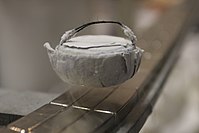
Photo from wikipedia
Although substantial effort has been dedicated to analyzing the Higgs (amplitude) mode in superconducting systems, there are relatively few studies of the Higgs peak's dispersion and width, quantities which are… Click to show full abstract
Although substantial effort has been dedicated to analyzing the Higgs (amplitude) mode in superconducting systems, there are relatively few studies of the Higgs peak's dispersion and width, quantities which are observable in spectroscopic measurements. These properties can be obtained from the location of the pole of the longitudinal (Higgs) susceptibility in the lower half-plane of complex frequency. We analyze the behavior of the Higgs mode in a 2D neutral fermionic superfluid at $T=0$ throughout the crossover from Bardeen-Cooper-Schrieffer (BCS) to Bose-Einstein condensation (BEC) behavior. This occurs when the dressed chemical potential $\mu$ changes sign from positive to negative. For $\mu>0$, we find a pole in the Higgs susceptibility in the lower half-plane of frequency and demonstrate that it leads to a well-defined peak in spectroscopic probes. For $\mu<0$, the pole still exists, but is"hidden,"not giving rise to a peak in spectroscopic probes. Extending this analysis to a charged superconductor, we find that the Higgs mode is unaffected by the long-range Coulomb interaction.
Journal Title: Physical Review B
Year Published: 2023
Link to full text (if available)
Share on Social Media: Sign Up to like & get
recommendations!